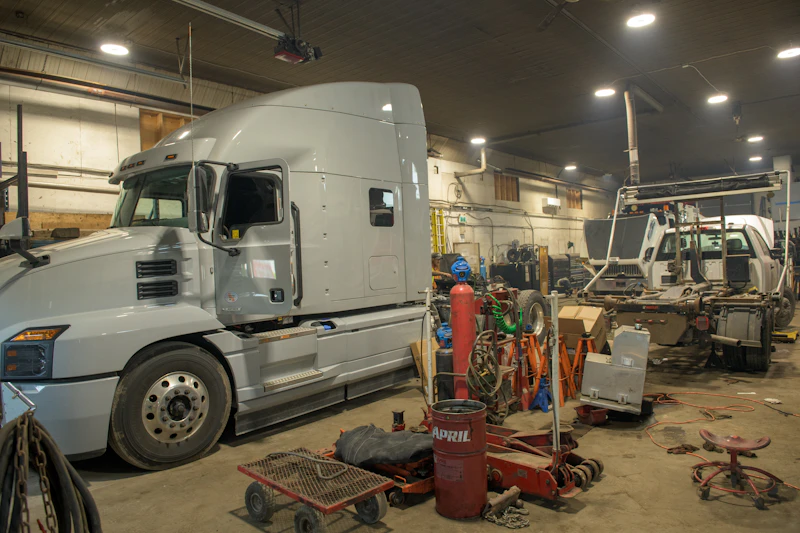Winterizing Air Brake Systems in Heavy-Duty Trucks: Inspection and Maintenance Tips

When winter’s harsh conditions arrive, it presents a unique set of challenges for your heavy-duty truck’s air brake systems. Safety should always be your number one priority, even more so when you’re met with poor visibility and icy roads. Remember, safety starts with a well-maintained break system.
Here we'll dive into winterizing air brake systems, offering comprehensive inspection and maintenance tips. Here you’ll find everything that you need to know to keep your brakes in optimal condition for the winter months, keeping you and other drivers safe.
Understanding Air Brake Systems
Air brake systems are responsible for slowing and stopping your vehicle. They consist of several critical components, including the air compressor, air lines, brake chambers, and more. Understanding how these components work is essential for winter maintenance.
Air brake systems work by using compressed air to push brake pads against the brake drums, creating friction and stopping the vehicle. This system is highly effective and reliable when properly maintained.
Winter Challenges for Air Brake Systems
Winter weather poses unique challenges to air brake systems. Cold temperatures, snow, and ice can adversely affect these critical components and their effectiveness. Here are some common issues:
Risk of Brake Freezing
Sub-zero temperatures can cause moisture within the air brake system to freeze, leading to potentially disastrous consequences. Frozen brake lines can prevent the brakes from releasing, resulting in poor vehicle control.
Reduced Air Pressure
Cold air is denser, which can lead to a drop in air pressure within the system. Reduced air pressure means the brakes won't engage as effectively, increasing stopping distances and compromising safety.
Brake Failures in Winter
The cumulative effects of moisture, reduced air pressure, and freezing can ultimately lead to brake failures, putting your drivers and cargo in danger.
Inspection Checklist
During the winter months, thoroughly inspecting your vehicle before any trips is essential to safety on the road. Below are three areas to consider when creating your own inspection checklist:
1. Visual Inspections
Examine air lines, connections, and fittings for signs of wear, damage, or leaks. Tighten or replace as necessary.
Inspect brake chambers, ensuring they are secure, leak-free, and free from damage.
2. Air Leaks
Carefully inspect the entire system for air leaks. Even minor leaks can lead to reduced brake efficiency. Use a soap solution to pinpoint leak locations.
3. Lubrication
Proper lubrication of moving parts is vital. Ensure that all pivot points and slack adjusters are well-lubricated to prevent rust and maintain smooth operation.
Maintenance Tips
Preventative maintenance is the key to keeping your air brake system in top shape during the winter. Here are some crucial tips:
Moisture Drainage
To prevent moisture from freezing within the system, regularly drain the air tanks. This is a simple yet effective measure to keep your brakes working in the cold.
Anti-Freeze Solutions
In extremely cold climates, consider using anti-freeze or alcohol-based solutions in the air tanks to prevent moisture accumulation. These solutions lower the freezing point of the moisture, keeping your system operational.
Keeping Air Tanks and Valves Clean
Regularly clean air tanks and valves to remove dirt and debris. Clean components work more efficiently, reducing the risk of blockages and failures.
Brake Adjustment and Alignment
Ensuring that your brakes are properly adjusted and aligned is essential for winter driving. This prevents wheel lock-up and skidding on icy roads.
Brake Balancing
Proper brake balance is crucial to prevent the locking of individual wheels, which can lead to accidents. Regular checks and adjustments can ensure even brake performance.
Professional Help
Safety on the road is not something to gamble on. Requesting the help of professional mechanics to resolve any brake issues is an investment that always pays off.
Emergency Response
Sometimes, even after following all of the maintenance tips listed above, your air brakes may fail. It’s important to remember to keep your cool in this situation and follow these bits of advice:
Emergency Brake Application
In case of brake failure, perform an emergency brake application. This involves pulling the brake release valve to gradually stop the vehicle.
Frozen Brakes
If the brakes freeze, use a heating source (e.g., a torch or warm water) to thaw them. Exercise caution when applying heat to avoid damaging components.
Regulatory Compliance
Meeting both local and federal regulations and standards around air brake systems is essential. Always adhere to the applicable rules and ensure your fleet complies with safety requirements in your area.
Final Words
Winterizing the air brake systems in your heavy-duty trucks is a critical aspect of fleet management. Proper understanding, inspection, and maintenance of these systems can make the difference between a safe journey and a dangerous one. By following the guidelines in this article, you'll not only ensure the safety of your drivers but also the reliability of your fleet during the harshest winter conditions.


.webp)
.webp)